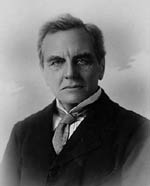William Johnson Sollas
William Johnson Sollas (born May 30, 1849 in Birmingham , † October 20, 1936 ) was a British geologist, paleontologist, zoologist, chemist and anthropologist.
Life
Sollas attended the City of London School and studied chemistry from 1865 at the Royal College of Chemistry. From 1867 he studied at the Royal School of Mines with Thomas Henry Huxley, among others, and went to Cambridge University (St. John's College), where he switched to geology under Thomas George Bonney and graduated in 1873 with top marks in the Tripos exams in natural sciences . He was then six years University Extension Lecturer in Cambridge and from 1879 Lecturer in Geology and Zoology at University College in Bristol , where he was Professor of Geology in 1880.
In 1883 he became a professor at Trinity College in Dublin and in 1897 at Oxford University . He expanded the geological faculty in Oxford, but there he turned more and more from the teaching he left to his demonstrator JA Douglas, and devoted himself to research, especially archaeological excavations, for example in the Paviland Cave in South Wales.
He dealt among other things with sponges, both recent (to which he contributed in the reports of the Challenger expedition in 1888) and fossil, and here in particular from the chalk (Cambridge Greensand). In Bristol he turned to the regional geology and fossils of the Silurian Mountains in nearby Wales and studied plesiosaurs . In Ireland he examined the granites there petrographically and chemically using a column diffusion method he developed. Another focus was crystallographic work. He also discovered ring-shaped halo structures around zircons, which he attributed to new elements, which was later confirmed by his colleague John Joly in Dublin (they were a result of radioactive decay). He also developed new refined methods for preparing fossils, first in his studies on sponges. In 1896 he traveled to Funafuti in the Pacific to study the formation of coral reef atolls.
In 1907 he received the Wollaston Medal of the Geological Society of London , of which he was president from 1908 to 1910. He was since 1880 Fellow of the Royal Society of Edinburgh , and since 1889 the Royal Society , the Royal Medal he received the 1,914th In 1893 he received the Bigsby Medal. The Sollas Glacier in Antarctica is named in his honor .
His daughter translated under his guidance , the face of the earth by Eduard Suess into English.
Others
It has also been linked to the Piltdown Man's hoax , but this has not been confirmed.
Fonts
- The Age of the Earth and other geological Studies, London 1905 (essays)
- Ancient Hunters and their modern representatives London 1911, 3rd edition 1924
- The rocks of Cape Colville Peninsula, Auckland, New Zealand, 2 volumes, Wellington, New Zealand 1905, 1906
Web links
- Entry in the Dictionary of Scientific Biography by JM Edmonds
Individual evidence
- ^ Fellows Directory. Biographical Index: Former RSE Fellows 1783–2002. (PDF file) Royal Society of Edinburgh, accessed April 10, 2020 .
- ↑ Keith Stewart Thomson Piltdown Man , 1991
| personal data | |
|---|---|
| SURNAME | Sollas, William Johnson |
| BRIEF DESCRIPTION | British geologist |
| DATE OF BIRTH | May 30, 1849 |
| PLACE OF BIRTH | Birmingham |
| DATE OF DEATH | October 20, 1936 |
